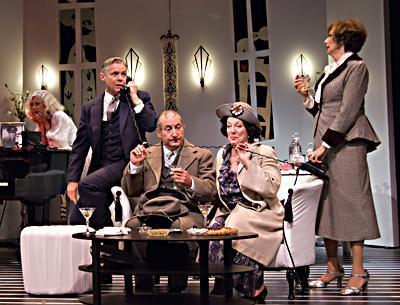Opinion: A Noel Coward Trio at John Drew

A trio of Noel Coward’s “after-dinner mints” is being served at the John Drew Theater at Guild Hall, and all in all they will leave a fine taste in your mouth.
Directed by one of America’s theater treasures, Tony Walton, “Tonight at 8:30” consists of three Coward one-acts, with one intermission, which he performed during the 1930s with his longtime friend and working partner Gertrude Lawrence. The pair would tour across England together, each night presenting three of Coward’s 10 one-act plays.
The selection of plays here is an excellent one, each offering a different facet of the diamond that is Coward’s work. Mr. Walton said recently that the playwright considered this cycle of one-acts “after-dinner mints.” They are ephemeral, which should not be confused with lacking substance.
The director has assembled a superb cast of supporting players to surround his two stars, Simon Jones and Blythe Danner. Mr. Jones, who plays the parts Noel Coward created for himself, is very much up to the challenge. He gives us a sophistication and understanding of the Coward genre rarely seen in American productions.
Ms. Danner plays two of the roles created by Gertrude Lawrence. Her performance had some fine moments, but was uneven. On Saturday night, she was at her best in the second of the three, “Family Album,” a deliciously darker side of Coward in which Papa has passed away and his Featherways progeny have gathered at the manor after the funeral to divide up the spoils. All seem quite giddy except for Lavinia Featherways, played with a wonderful calm by Ms. Danner. She knows something the others don’t know — as does the butler, Burrows, played by Tuck Milligan, who is a fabulous character actor. The secret the two share gives us a wonderful plot twist that bridges the gap between the upstairs Featherways and the downstairs Burrows.
The part of Jane Featherways, originally created by Ms. Lawrence, is played winningly by Delphi Harrington.
Bridging the chasm between the classes is a bridge too far in the first play of the evening, “Hands Across the Sea.” It is Coward at his biting, satirical best. Lady Maureen Gilpin (Ms. Danner), better known to her friends as Piggie, is expecting the Rawlingtons, at whose rubber plantation she’d spent a few days on her trip to Malaya, when the maid, played by Tina Jones (I would put this group of supporting actors up against any on Broadway), shows in a working-class couple, played by Kate Mueth and Gerard Doyle. Ms. Mueth and Mr. Doyle are so precise and measured in their characterizations that you will laugh, and laugh hard.
Coward depicts a petty, vain, self-centered ruling class, with Piggie leading the way. When the inevitable plot twist comes, Mr. Jones, playing Piggie’s husband, Commander Peter Gilfin R.N., practically channels Noel Coward on the piano, playfully goading his wife into action.
It was in this play, particularly up until the plot twist, that Ms. Danner seemed a bit off. She stammered some of her lines — a character choice, perhaps — and was awfully busy. Perhaps she was under the weather. This is a funny play, but it could be funnier.
The actress did find her feet, though, from that point on. For what it’s worth, this is the only one of the three plays she has done previously.
The third play, “Red Peppers,” is a poignant piece of writing in which a down-on-their-luck, fading vaudeville couple, George (Mr. Jones) and Lily (Ms. Danner), bicker with each other, and with the world around them. Mr. Jones demonstrates in this play, especially in the song-and-dance routines, that his “Cowardism” is second to none, and Ms. Danner was bitingly funny when she let down her hair in the dressing room.
The production values, as you would expect from any play directed by Mr. Walton, are out-of-this-world good. He has a keen eye and a deep understanding of the material and of theater, doing many subtle things to weave the three separate plays into one cohesive evening. (It was Noel Coward himself who gave a young Mr. Walton his first Broadway break, hiring him to design scenery and lights for “Conversation Piece” in 1957.)
Heather Wolensky’s stunning set is flexible, evolving throughout the evening. She has designed a proscenium arch within the actual proscenium arch, with the inner one resembling fine lace-paper cutouts. Mr. Walton spoke last month of how Hans Christian Andersen would make fine paper cutouts as he was telling his stories: Ms. Wolensky has executed the director’s vision perfectly.
Even the scene changes are beautifully done, with stagehands dressed as English maids and servants. All these small details help to make the evening such a winning one, including using the excellent music director, Bobby Peterson, as a character in the first play, then having him play the piano on stage through the set change to the next play, even as the piano itself is moving. I would go back to watch the set changes alone.
The lighting design by Sebastian Parczynski sets off the set and the players perfectly, and the costumes, designed by Whitney Anne Adams, capture the period perfectly as well. The props, designed by Sarah Azzara, are both practical and period.
After Saturday night’s performance, Mr. Walton was joined at the back of the house by his ex-wife, Julie Andrews. The two spoke for a couple of minutes. Seeing these two English-born legends of the American stage together, both of them products of the halcyon 1950s, was magical. Mr. Walton has brought some of that magic to the John Drew Theater.
